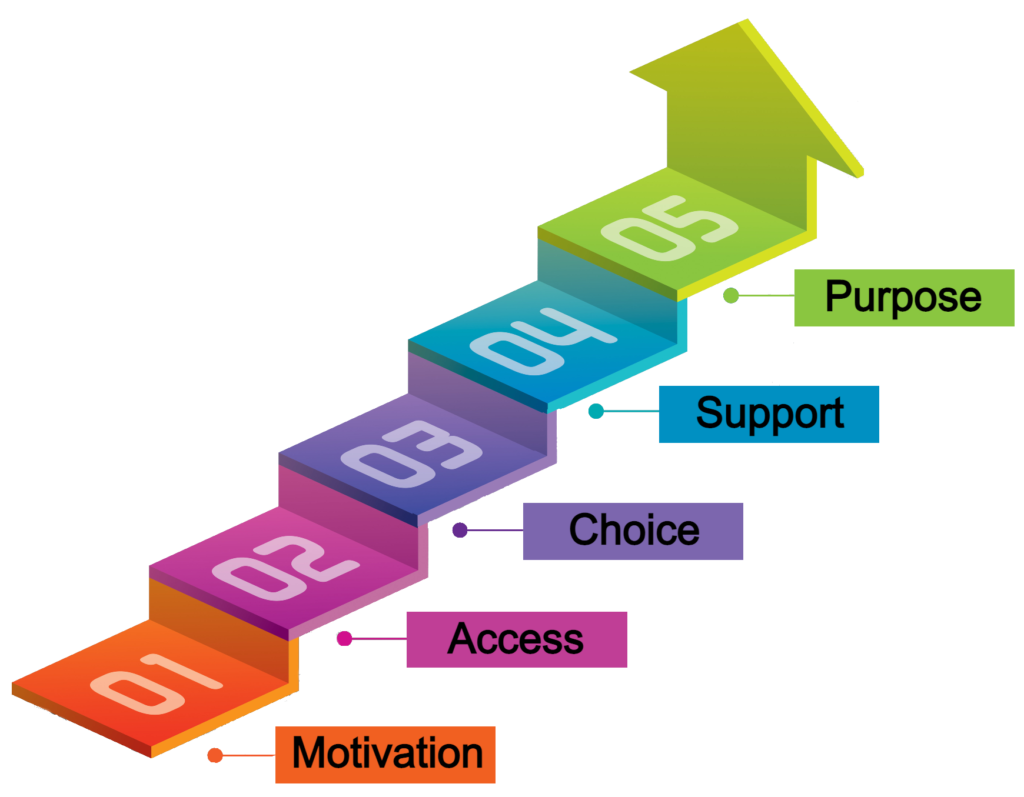The most important point to remember is that teaching is not learning, and teaching does not necessarily produce learning. The mistake most schools make when attempting to increase student achievement is to teach more and better lessons. Lessons may not actually be the key to learning . . . and especially not whole-class lessons that cannot be fully differentiated.
The pandemic left schools with classrooms of children who have not all progressed at the same level or with the same content. Learning gaps abound across the group. Two students may have progressed well, but with each excelling at different skills. Teachers need to embrace student-focused, differentiated learning environments now more than ever. Knowing how the brain learns helps in the quest for learning acceleration.
Let’s start with Five Steps to Learning Acceleration:

Motivation — In my blog post on designing hybrid learning activities (those that work as well at home as they do in school), I share a “brain’s-eye view” of learning progression:

The first step toward learning acceleration is to capture the brain’s attention by causing it to think, “Wait, I don’t know this!” That produces cognitive dissonance, which engages the brain. At the right level, that’s motivational to the brain. Right level? If the “unknown” is just out of reach, the brain will be motivated to figure it out. If it’s far out of reach, the brain will turn off to it. (Your brain is very efficient and doesn’t waste energy.) It helps to ensure the learning connects to a context so that there is even more of a reason to learn. Consider that students learn all the time without teachers: how to beat the next level of a video game, how to mix colors to get new colors, how to perform a new trick on a skateboard, how to sing a favorite song, etc. Real-world context helps in learning acceleration. The 5 Ps of PBL are great for engaging students in learning. Engagement is key in raising student achievement. When students are motivated, they will pursue learning with or without teachers’ lessons!
Access — Once the brain determines it needs to learn, it seeks the best and easiest path there (again, efficient!) Ensure that students have differentiated opportunities to learn that are culturally relevant and match their cognitive readiness and learning-style preferences. The same instructional lesson for all cannot provide these characteristics. Instead, consider videos, learning centers, websites, text-based learning activities, and small-group instruction. Differentiation will provide each student with access to rigorous learning opportunities. As students have access to appropriate learning activities, they enjoy success, which motivates them to learn more! Consider using a 3×3 grid to brainstorm different ways to learn the same content. Consider how you are providing representation for all of your students.
Choice — Empower students by providing them with choice and responsibility for their own learning. Give students choice over how, where, with whom, and when they tackle learning activities. (See our Student-Driven Learning Components.) Have students schedule how they will use their time addressing their personalized learning goals. Empowered students require less attention for behavioral issues because they remain engaged in learning.
Support — Facilitate student learning by observing their process, asking questions, and guiding them in their learning. Provide students with the inspiration, connections, resources, and instruction they need. The facilitation roadmap is a great guide for determining how a student is “feeling” in the learning process and then taking appropriate action. A content facilitation grid allows you to track individual student progress, thus targeting instruction for individualized acceleration.
Purpose — Improve retention of learning by ensuring students have a reason to learn the content. Have students apply learning to develop products for a real-world audience. “If you give a kid a real-world problem,” you’ll see the progression through these steps toward solidifying the purpose for learning.
Learning acceleration is a matter of putting students in charge of their own learning, where their own interests and successive achievements fuel their desire for more learning.

Professional Development Options
- – EdQuiddity Inc offers a self-paced professional learning experience in Reinventing the Classroom Experience: Learning Anywhere, Anytime, which prioritizes learning acceleration and academic resilience. Tell me more!
- – EdQuiddity Inc offers consultant-facilitated Virtual Learning Communities on a variety of topics, including those related to learning acceleration, such as PBL, executive function, differentiated activity lists, facilitation, academic resilience, and more. Tell me more!
- – IDE Corp. provides customized, in-person, on-site and remote professional learning experiences for educators. Tell me more!
